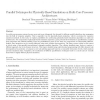Free Online Productivity Tools
i2Speak
i2Symbol
i2OCR
iTex2Img
iWeb2Print
iWeb2Shot
i2Type
iPdf2Split
iPdf2Merge
i2Bopomofo
i2Arabic
i2Style
i2Image
i2PDF
iLatex2Rtf
Sci2ools
CG
2008
Springer
2008
Springer
Parallel techniques for physically based simulation on multi-core processor architectures
As multi-core processor systems become more and more widespread, the demand for efficient parallel algorithms also propagates into the field of computer graphics. This is especially true for physically-based simulation, which is notorious for expensive numerical methods. In this work, we explore possibilities for accelerating physically-based simulation algorithms on multi-core architectures. Two components of physically-based simulation represent a great potential for bottlenecks in parallelisation: implicit time integration and collision handling. From the parallelisation point of view these two components are substantially different. Implicit time integration can be treated efficiently using static problem decomposition. The linear system arising in this context is solved using a data-parallel preconditioned conjugate gradient algorithm. The collision handling stage, however, requires a different approach, due to its dynamic structure. This stage is handled using multi-threaded pro...
CG 2008 | Computer Graphics | Implicit Time Integration | Multi-core Processors | Physically-based Simulation |
| Added | 09 Dec 2010 |
| Updated | 09 Dec 2010 |
| Type | Journal |
| Year | 2008 |
| Where | CG |
| Authors | Bernhard Thomaszewski, Simon Pabst, Wolfgang Blochinger |
Comments (0)

